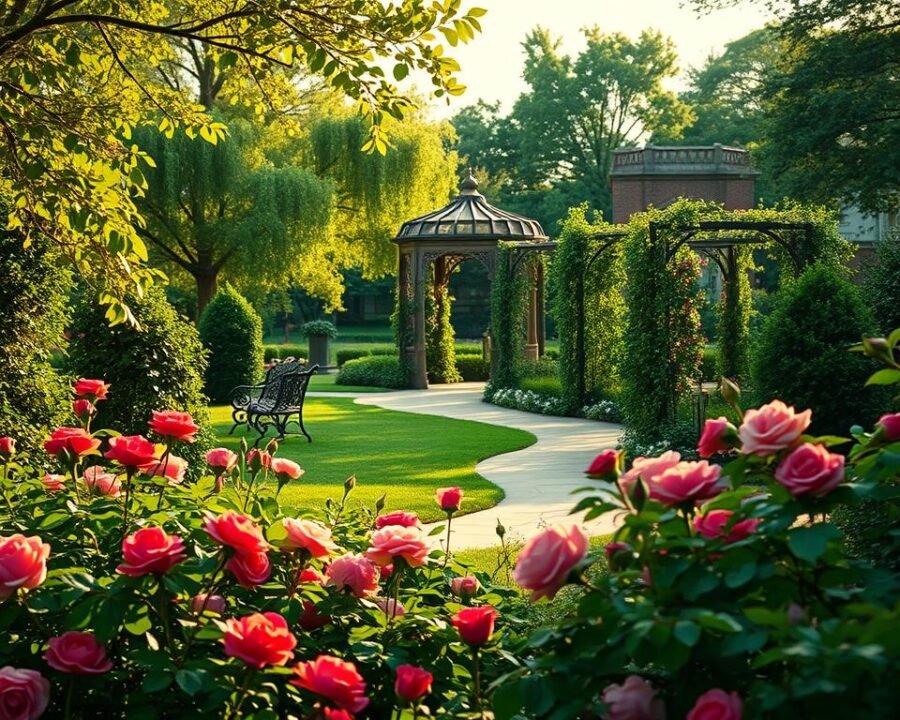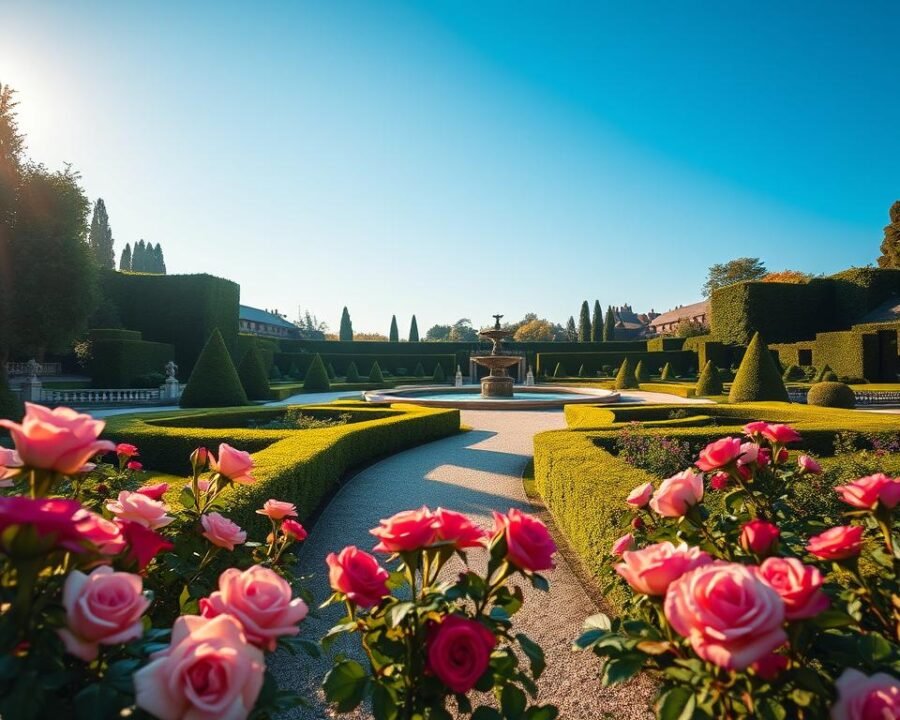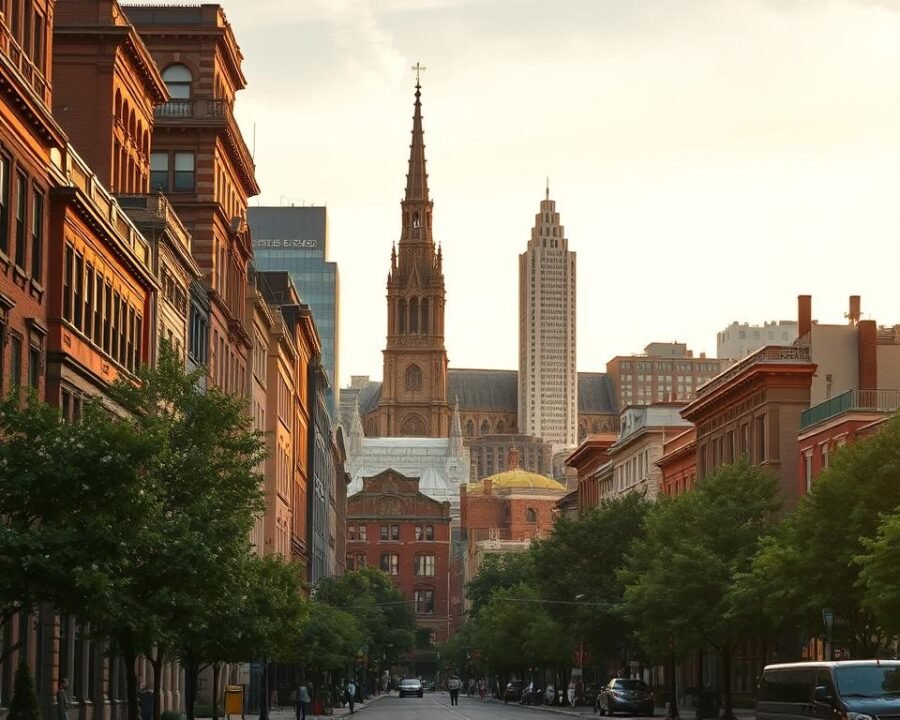Nestled in the heart of Boston’s Back Bay Fens, the James P. Kelleher Rose Garden is a hidden gem that offers a peaceful escape from the city’s hustle and bustle. With over 1,500 roses in more than 200 varieties, this enchanting space is a haven for nature lovers and those seeking tranquility.
Just a short walk from Fenway Park and other major Boston landmarks, this garden blends historical significance with natural beauty. Its arched trellises, elegant statues, and seasonal blooms create a picturesque setting that feels like stepping into a secret world. Whether you’re a local or a visitor, the serene ambiance of this place is sure to leave a lasting impression.
Founded in 1931, the garden has been a cherished spot for decades. Its winding paths, shaded gazebos, and quiet benches invite you to slow down and savor the moment. It’s more than just a garden—it’s a place where history, nature, and serenity come together.
Key Takeaways
- Located in Boston’s Back Bay Fens, offering a peaceful retreat.
- Home to over 1,500 roses in 200+ varieties.
- Close to Fenway Park and other major Boston attractions.
- Features arched trellises, statues, and seasonal blooms.
- Established in 1931, blending history with natural beauty.
- Perfect for relaxation, photography, and quiet reflection.
Introduction to the James P. Kelleher Rose Garden
Tucked away in Boston’s Back Bay Fens, this serene destination offers a unique blend of history and nature. Founded in 1931, it was designed by Arthur Shurcliff and features over 1,500 roses. This space is not just a garden—it’s a conservation area for hybridized roses, preserving their beauty for future generations.
Despite its central location, the garden has earned a reputation as a “secret garden.” Its quiet pathways and lush blooms create a sense of seclusion, making it a perfect escape from the city’s hustle. Visitors often describe it as a hidden oasis, offering a peaceful retreat just steps away from Fenway Park and local universities.
The garden’s design contrasts sharply with the wild, natural layout of the Back Bay Fens, originally envisioned by Frederick Law Olmsted. Shurcliff’s structured approach brings order and elegance, with arched trellises and carefully arranged flower beds. This blend of styles makes it a unique destination for both locals and tourists.
Recent renovations have further enhanced its appeal. Reopened in 2019, the garden now boasts improved pathways and updated facilities. It remains a beloved spot for relaxation, photography, and quiet reflection. Here’s a quick guide to visiting:
| Feature | Details |
|---|---|
| Visitor Hours | Daily, 7 AM – 8 PM |
| Accessibility | Wheelchair-friendly paths |
| Best Time to Visit | Late spring to early fall |
Whether you’re a nature enthusiast or simply looking for a quiet spot, this garden is a must-visit. Its combination of history, beauty, and accessibility makes it a standout destination in Boston downtown.
The History of the James P. Kelleher Rose Garden

The story of this urban oasis begins in 1931, when it was first envisioned as a refined escape. Commissioned by Mayor James Michael Curley, the project aimed to create a public space that combined elegance with natural beauty. Designed by Arthur Shurcliff, a protégé of Frederick Law Olmsted, the garden was a bold departure from the wild, natural style of the Back Bay Fens.
Initially, the garden faced criticism. Some saw it as a “gaudy intrusion” on Olmsted’s original vision for the Fens. However, over time, it became a cherished fixture in Boston. Its structured design, featuring arched trellises and meticulously arranged flower beds, won the 1932 Horticultural Society award, cementing its place in the city’s history.
Origins and Commissioning
Mayor Curley’s vision was to create a place where residents could enjoy a refined urban green space. Shurcliff, who had apprenticed under Olmsted, brought his expertise to the project. His design blended order and elegance, creating a space that felt both formal and inviting.
Recognition and Evolution
Over the decades, the garden’s reputation grew. What was once criticized became a beloved destination for locals and visitors alike. Recent renovations, completed in 2018, restored its accessibility and enhanced its charm. Today, it stands as a testament to the enduring appeal of well-designed parks.
- Mayor Curley’s 1931 vision for a refined urban green space
- Arthur Shurcliff’s apprenticeship under Frederick Law Olmsted
- Initial criticism as a “gaudy intrusion” on Olmsted’s natural Fens landscape
- Shift in public perception over decades to become a beloved Boston fixture
- Post-2018 renovations and restored accessibility
The Design and Layout of the Garden

Arthur Shurcliff’s vision transformed this area into a structured yet inviting retreat. His English-style design blends symmetry with Boston’s natural terrain, creating a space that feels both refined and harmonious. The result is a landscape that invites visitors to explore and relax.
Arthur Shurcliff’s Vision
Shurcliff’s approach was rooted in balance. He combined formal elements like brick pathways and ornamental iron gates with the wild charm of the surrounding area. This duality makes the space unique, offering both structure and a sense of natural freedom.
Architectural Features
The garden’s design includes several standout features. Arched trellises support climbing flowers, while a central fountain serves as a focal point. Shaded seating areas and brick pathways invite visitors to linger and enjoy the view.
Post-renovation changes have enhanced the space. The removal of yew hedges improved visibility, allowing the beauty of the plants and statues to shine. Seasonal rotations of blooms ensure the gardens remain vibrant throughout the year.
Location and Accessibility

Just steps away from Boston’s bustling streets, this tranquil space offers a peaceful retreat. Located in the Back Bay area, it’s a short walk from iconic landmarks like Fenway Park, Northeastern University, and Boylston Street. Whether you’re a local or a visitor, this spot is easy to reach and perfect for a quiet escape.
Proximity to Boston Landmarks
The garden is nestled in the Bay Fens, making it a convenient stop on any Boston itinerary. It’s just a 10-minute walk from the Museum of Fine Arts, where you can explore world-class exhibits. Public transit options, including the MBTA Green Line, make it accessible for everyone.
Visiting Hours and Parking
Open from May to October, the garden welcomes visitors daily from 7 a.m. to 5 p.m. Admission is free, making it an affordable place to unwind. For those driving, metered parking is available behind the Museum of Fine Arts.
Accessibility is a priority here. The garden features wheelchair-friendly paths and stroller access, ensuring everyone can enjoy its beauty. Whether you’re planning a quick visit or a leisurely stroll, this spot is a must-see in Boston.
The Flora of the James P. Kelleher Rose Garden
The James P. Kelleher Rose Garden is a vibrant showcase of over 200 varieties of roses, each contributing to its unique charm. From hybrid teas to floribundas and climbers, the garden is a living catalog of these beloved flowers. Their bloom cycles stretch from late spring to the first frost, ensuring a colorful display for most of the year.
Variety of Roses
Among the many roses, you’ll find hybridized varieties like the ‘Justine Mee Liff’ Rose, planted in 2005. This specific variety, created by Paul E. Jerabek, adds a unique touch to the collection. The garden’s design allows each type to shine, with bushes arranged to highlight their individual beauty.
Other Plants and Landscape Features
Beyond the roses, the garden features companion plants like lavender, salvia, and boxwood hedges. These additions enhance the visual appeal and support the ecosystem. Pollinators such as bees and butterflies are frequent visitors, playing a vital role in maintaining the garden’s health.
For photographers, the best times to capture the vibrant colors are early morning or late afternoon. The soft light during these hours brings out the rich hues of the flowers, making every shot a masterpiece.
To learn more about the varieties of roses and their history, visit the official guide. This garden is not just a feast for the eyes but also a testament to the beauty of nature’s diversity.
The Secret Garden Feel
Amidst the urban buzz of Boston, this serene space feels like a hidden treasure. Despite its central location, it retains a secluded ambiance that makes it a favorite among locals. The contrast between the city’s hustle and the garden’s tranquility creates a unique experience.
Hidden Gem in the City
Longtime Boston residents often share stories of seasonal traditions here. From spring picnics to autumn strolls, this spot has become a cherished part of their routines. Its quiet pathways and lush blooms offer a peaceful escape from daily life.
“It’s like stepping into another world—calm, beautiful, and timeless.”
Community and Public Perception
This space is more than just a community garden; it’s a destination for connection and reflection. Social media trends like #BostonHiddenGems have brought it into the spotlight, attracting visitors from all over. Yet, it remains a beloved spot for locals.
Volunteer opportunities for rose care and educational programs foster a sense of ownership and pride. Whether it’s a wedding, a quiet moment, or a photo session, this place continues to inspire.
| Activity | Popularity |
|---|---|
| Picnics | High |
| Weddings | Moderate |
| Quiet Reflection | Very High |
Recent Updates and Renovations
In recent years, this beloved space has undergone significant transformations to enhance its charm. From 2018 to 2019, it was temporarily closed for upgrades, ensuring it remains a vibrant part of the public landscape. These changes have made it more accessible and enjoyable for everyone.
Construction and Reopening
During the closure, the focus was on improving the infrastructure. Key updates included modernizing the irrigation system and revitalizing the soil to support healthier plants. These changes ensure the gardens thrive year-round, offering visitors a stunning display of blooms.
Post-reopening, the space now features ADA-compliant pathways and clear signage, making it easier for all visitors to navigate. These enhancements reflect a commitment to inclusivity and accessibility in parks.
Current State and Future Plans
Today, the space is more vibrant than ever, with plans to expand the variety of roses and introduce community workshops. These initiatives aim to engage visitors and foster a deeper connection with nature.
“The updates have made this place even more special. It’s now easier to explore and enjoy.”
Partnerships with local horticultural societies ensure the space continues to evolve. These collaborations bring expertise and innovation, keeping this destination a cherished part of the landscape.
Conclusion: Why Visit the James P. Kelleher Rose Garden?
A perfect blend of history, design, and natural beauty awaits visitors at this iconic spot. Whether you’re a nature lover, history buff, or photography enthusiast, this destination offers something for everyone. Its free admission and proximity to other Boston attractions make it a must-visit place.
Seasonal highlights, like the vibrant June blooms and stunning autumn foliage, add to its charm. The kelleher rose garden is more than just a community garden—it’s a serene escape in the heart of the city.
Plan your visit today using the provided hours and parking tips. Explore the varieties of roses and immerse yourself in this timeless retreat.
